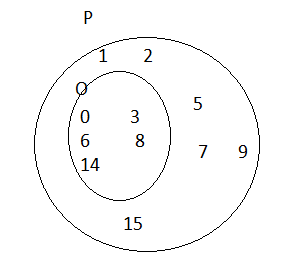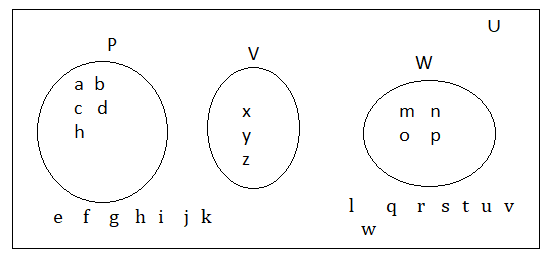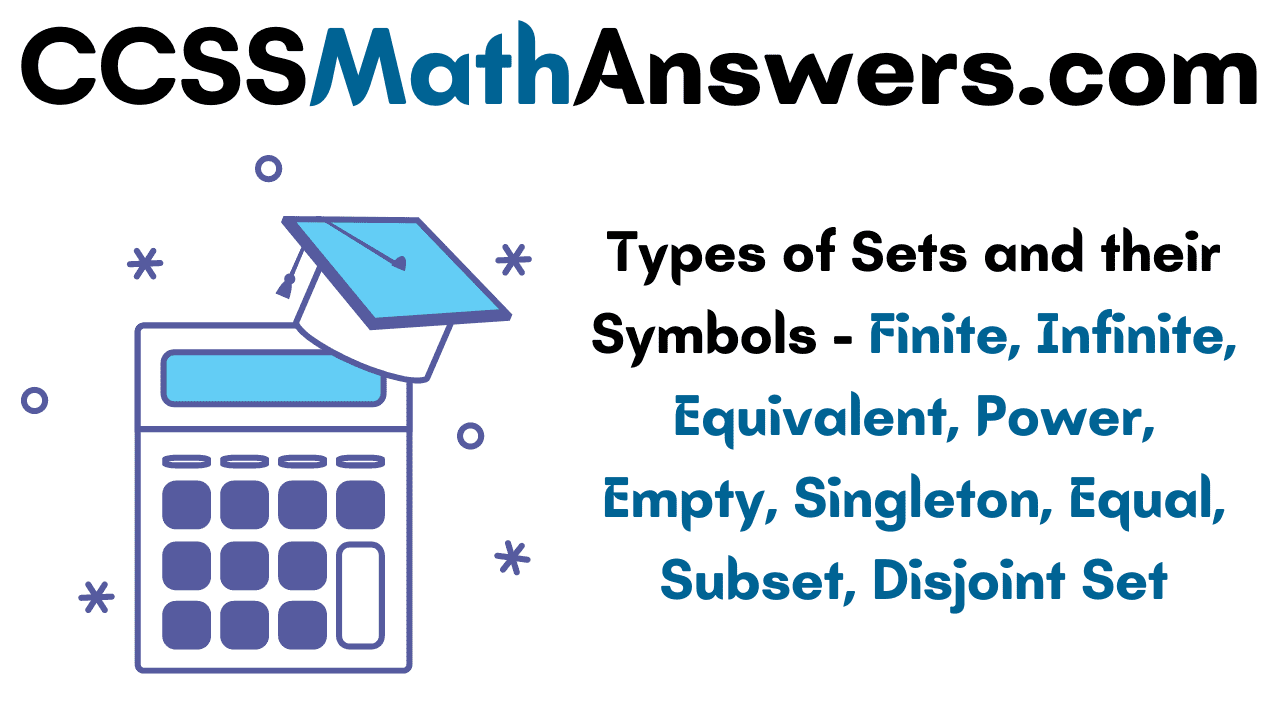In mathematics, a set is a collection of well-defined objects. Those objects are called members or elements of a set. The set elements are closed between the curly braces and each element is broken up by a comma. The sets are classified into various types. Interested students can go through the following sections to check useful information on set types. You can see definitions and examples for all sets.
Set Types
Based on the elements on the set, size of the set, and other factors, sets are divided into various types. They are listed here.
- Finite Set
- Null Set
- Infinite set
- Equal Sets
- Singleton Set
- Equivalent Sets
- Subset
- Proper Subset
- Cardinal Number of a set
- Power Set
- Superset
- Disjoint Sets
- Universal Set
Types of Sets
Let us discuss the definition and examples of all types of sets in the below sections.
1. Empty Set
If a set has no elements in it, then it is called the empty set. It is also known as the null set or void set. An empty set is represented by ϕ or {}.
Examples:
A = { x : x is a whole number that is not a natural number, x ≠ 0}
Zero is the only whole number that is not a natural number. If x ≠ 0, then there is no possible value for x. So, A = ϕ.
B = { y : 1 < y < 2, y is a natural number}
We know that a natural number cannot be a decimal. So, set y is a null set.
2. Finite Set
A finite set has a definite number of elements. We can find the size of the finite set easily.
Examples:
C = { x | x is a natural number, 20 > x > 10 }
D = { t, y, p, e, s, o, f, s, e, t, s }
3. Infinite Set
A set that has an infinite number of elements in it is called the infinite set. It is not possible to find the size of an infinite set.
Examples:
E = { x : x is a whole number, x > 50 }
The set of whole numbers greater than 50 are 51, 52, 53, 54, . . . . Therefore, set E is an infinite set.
F = { x | x is an even number and x >2 }
The set of even numbers greater than 2 are 4, 6, 8, 10, 12, 14, 16, 18, 20, . . . Hence, set F is an infinite set.
4. Singleton Set
Singleton set is also known as a unit set. If a set has only one element, then it is called the singleton set. The size of a unit set is always 1.
Examples:
G = {5}
As set G has only one element it is a singleton set.
H = {x : x is whole number but not natural number }
We have only one element which is the whole number, not a natural number i.e 0. So, H is a singleton set.
5. Equal Sets
If two sets contain the same elements, then they are equal sets. There is no need to have the same order of elements in both sets.
Examples:
Let I = {4, 14, 15, 5, 6, 18} and J = {15, 5, 18, 14, 4, 6} are two sets.
Then I = J
Here, two sets have the same elements i.e 4, 5, 6, 14, 15, 18
6. Equivalent Sets
If two sets have the same number of elements, then they are called equivalent sets. Two sets order or cardinality is equal.
Examples:
Let K = {8, 17, 25, 63}, L = {56, 5, 45, 28}
The order of K = n(k) = 4
The order of L = n(L) = 4
So, L and K are equivalent sets.
Let M = {p, o, w, e, r}, N = {1, 5, 6, 8, 12}
n(M) = 5
n(N) = 5
So, M and n are equivalent sets.
7. Subset
A set A is said to be a subset of B if all the elements of A are the elements B. Subset is denoted by the symbol ⊂ and A ⊂ B.
Examples:
If O = {0, 3, 6, 8, 14}, P = {15, 5, 0, 1, 2, 3, 6, 14, 7, 8, 9}
The elements of P are 0, 1, 2, 3, 5, 6, 7, 8, 9, 14, and 15.
The elements of O are 0, 3, 6, 8, and 14.
All the elements of O belong to set P. So, O ⊆ P.

8. Proper Subset
If A, B are two sets, A is called the proper subset of B if A ⊂ B but B ⊃ A i.e A ≠ B. The symbol ⊆ is used to represent the proper subset.
Examples:
Q = {7, 5, 2, 16} and R = {2, 5, 7}
All the elements of R are in Q.
n(R) = 3, n(Q) = 4 and Q ≠ R
So, R ⊆ Q

9. Superset
When set A is a subset of set B, then B is a superset of A and it can be represented as B ⊇ A. The symbol ⊇ means “is a superset of”.
Examples:
Let S = {p, o, w, e, r}, T = {p, o, w, e, r, f, u, l}
Here, S ⊂ T. So, T ⊇ S.
10. Universal Set
A set that has all the elements of other given sets is known as the universal set. The symbol is ∪ or ξ.
Examples:
Let P = {a, b, c, d, h}, V = {x, y, z}, W = {m, n, o , p}
∪ = {a, b, c d, e, f, g h, i, j, k, l, m, n, o, p, q, r, s, t, u, v w, x, y, z}
So, ∪ is the universal set.

11. Disjoint Sets
Two sets A and B are called disjoint sets if they do not have common elements between them. So, the properties of disjoint sets are n(A ∩ B) = { }, n(A U B) = n(A) + n(B)
Examples:
X = {1, 2, 5}, Y = {8, 6, 3}
Here, X and y sets has no common element. So X, Y are disjoint sets.

12. Cardinal Number of a set
The number of different elements in the set is called the cardinal number of a set. It is denoted by n(A).
Examples:
Y = { x : x is a natural number, n >10}
n(Y) = 9
Z = {n, u, m, b, e, r, o, f, e, l, e, m, e, n, t, s}
n(Z) = 16
13. Power Set
The set of all subsets is called the power sets. We know that an empty set is a subset of all sets and every set is a subset of itself.
Examples:
If set A = {1, 8, 15}, then power set of A is P(A) = {ϕ, {8}, {15, 8}, {1, 8}, {1, 15}, (8, 1, 15}, {15}, {1}}
Frequently Asked Questions on Set Types
1. How do you express an empty set?
An empty set has no element. it can be represented as ϕ or { }.
2. What are the two sets that contain the same elements?
If two sets have the same elements, then they are called equal sets. The example is A = {m, a, t, h, e, m, a, t, i, c, s} and B = {a, a, m, m, t, t, h, e, s, i, c}. So, A = B.
3. What is a Subset?
If A and B are two sets, and every element of set A is also an element of set B, then A is called a subset of B and expressed as A ⊂ B. B ⊇ A means B is a superset of A. A ⊆ B means A is a proper subset of B.
Read Similar Articles on Sets
